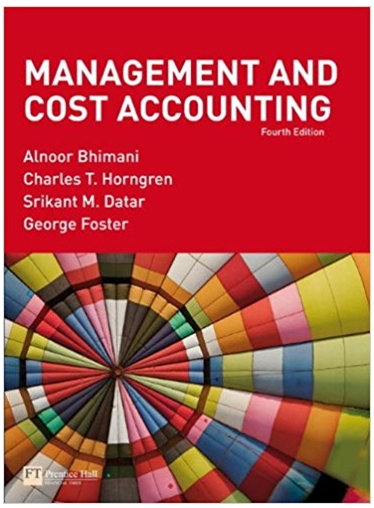

Kindly I need help. Thanks
Part A
1. Which of the following is a nonvalue-added activity?
A. Product design
B. Customer service
C. Research and development
D. Rework of defective items
2. A company's break-even point will not be increased by:
A. an increase in total fixed costs.
B. a decrease in the selling price per unit.
C. an increase in the variable cost per unit.
D. a decrease in the contribution margin ratio.
E. an increase in the number of units produced and sold.
3. Employee involvement is important in an effective performance measurement system because it:
A. increases the employee's commitment to the organization and its objectives.
B. decreases the employee's reliance on financial performance measures.
C. increases the likelihood that goal congruence problems will occur.
D. decreases the chances of an unfavorable manufacturing cycle time.
4. Manufacturing cycle efficiency is computed by dividing process time by:
A. moving time + storage time.
B. storage time + inspection time.
C. moving time + storage time + inspection time.
D. process time + inspection time + moving time.
E. process time + moving time + storage time + inspection time.
Part B
1. Which of the following statements is (are) true? (1). The term full cost refers to the cost of manufacturing and s g a unit of product and includes both fixed and variable costs. (2). The fixed cost per unit is considered constant despite changes in the volume of activity within the relevant range. A. Only (1) is true. B. Only (2) is true. C. Both (1) and (2) are true. D. Neither (1) nor (2) are true. 2. Which one of the following costs is classified as a period cost? A. The wages of a worker paid for idle time resulting from a machine breakdown in the molding department. B. The wages of the workers on the shipping docks who load completed products onto outgoing trucks. C. The payments for the employee (fringe) benefits paid on behalf of the workers in the manufacturing plant. D. The wages paid to workers for reworking defective products that failed the quality inspection upon completion. 3. Cost-volume-profit (CVP) analysis is a simple but powerful tool to assist management make operating decisions. Which of the following does not represent a potential use of CVP analysis? A. Ability to compute the break-even point. B. Aids in evaluating tax planning alternatives. C. Ability to determine optimal sales volumes. D. Aids in determining optimal pricing policies. 4. Break-even analysis assumes that over the relevant range. A. Total Fixed Costs are nonlinear. B. Total Costs are unchanged. C. Unit Revenues are nonlinear. D. Unit Variable Costs are unchanged.Exhibit 1 Wilkerson Company: Operating Results (March 2000) Exhibit 3 Product Data Sales $2.152.500 100% Direct Labor Expense 271,250 Product Lines Valves Pumps Flow Controllers Direct Materials Expense 458,000 Materials per unit 4 components 5 components 10 components Manufacturing overhead 2052 -$4 30 42 -56 Machine-related expenses $336,000 20 6- 12 20 7= 14 50 2= 10 Setup labor 40 000 10 8= Receiving and production control 180,000 Materials cost per unit $16 $20 $32 Engineering 100,000 Direct labor per unit :40 DL hours 50 DL hours 40 DL hours Packaging and shipping 150.000 Direct labor $/unit @ $25/DL hour $10 $12.50 $10.00 Total Manufacturing Overhead (including employee benefits) Gross Margin $617,250 Machine hours per unit 0.5 0.5 0.3 General, Selling & Admin. Expense 559,650 Operating Income (pre-tax) $ 57.600 3% Exhibit 4 Monthly Production and Operating Statistics (March 2000) Exhibit 2 Product Profitability Analysis (March 2000) Flow Valves Pumps Controllers Total Valves Pumps How Controllers Production (units) 7,500 12,500 24,000 Direct labor cost $10.00 $12.50 $10.00 Machine hours 3,750 6.250 1,200 1 1,200 Direct material cost 16.00 20.00 22.00 Production runs 10 50 1 00 160 Manufacturing overhead (8300%) 20.00 37.50 30,00 Number of shipments 10 220 300 Standard unit costs 556.00 $ 70.00 $ 62.00 Hours of engineering work 250 375 625 1.250 Target selling price $86. 15 $107.69 595.38 Planned gross margin (%) 35 Actual selling price 586.00 $87.00 $105.00 Actual gross margin ("%) 34.9% 19.5%% 41.0Advanced Electronic Company is a chipset maker manufactures and sells a variety of integrated circuit (IC) products. The company has three key product lines accounting for 90% of the total business. Revenue and cost data of the three product lines in the month of April are as follows: Product Model-1 Model-2 Model-3 Units produced and sold 4,000 6,000 10,000 Unit selling price $60 $50 $35 Direct materials $70,000 $160,000 $182,000 Direct labor $60,000 $70,000 $84,000 Machine hours consumed 300 hours 90 hours 60 hours The company adopts a simple costing system by allocating the manufacturing overhead based on the machine hours which are used to manufacture the three models. Manufacturing overhead incurred in the month includes the following: Activity $ Engineering 62,500 Quality control 15,000 Machinery 66,000 Materials handling 36,500 180,000 Recently the company has learned that an activity-based costing (ABC) system can provide more accurate cost information through analysing how the products use the activities during the operating processes. The following data are collected from operations for April: Activity Cost Driver Model-1 Model-2 Model-3 Engineering No. of engineering hours 60 100 240 Quality control No. of inspection hours 36 120 204 Machinery No. of machine hours 300 90 60 Materials handling No. of orders 5 5 20 Required: (a) Use the current simple costing system to prepare a product line and total (5 marks) company income statement with profitability % for the month of April. (b) Use the activity based costing system to prepare the product line and (8 marks) total company income statement with profitability % for the month of April. Show all your workings. (c) Compare and explain differences in product costs under the product (7 marks) costing systems in (a) and (b) above. What are the implications for the company's pricing strategy? (d) Identify four benefits that activity-based costing system would bring to (4 marks) the company











